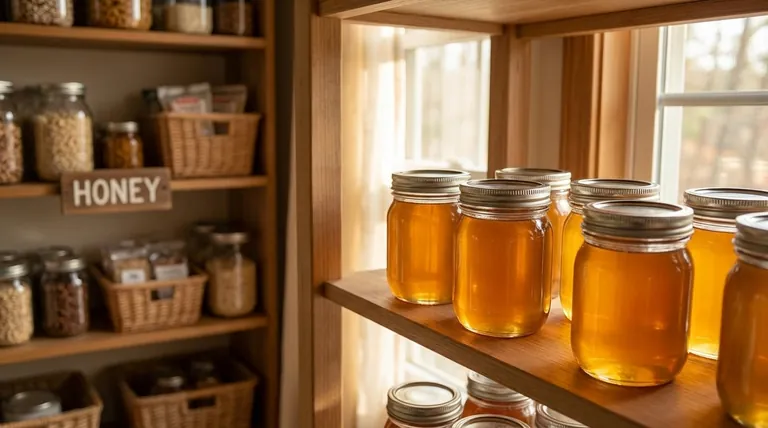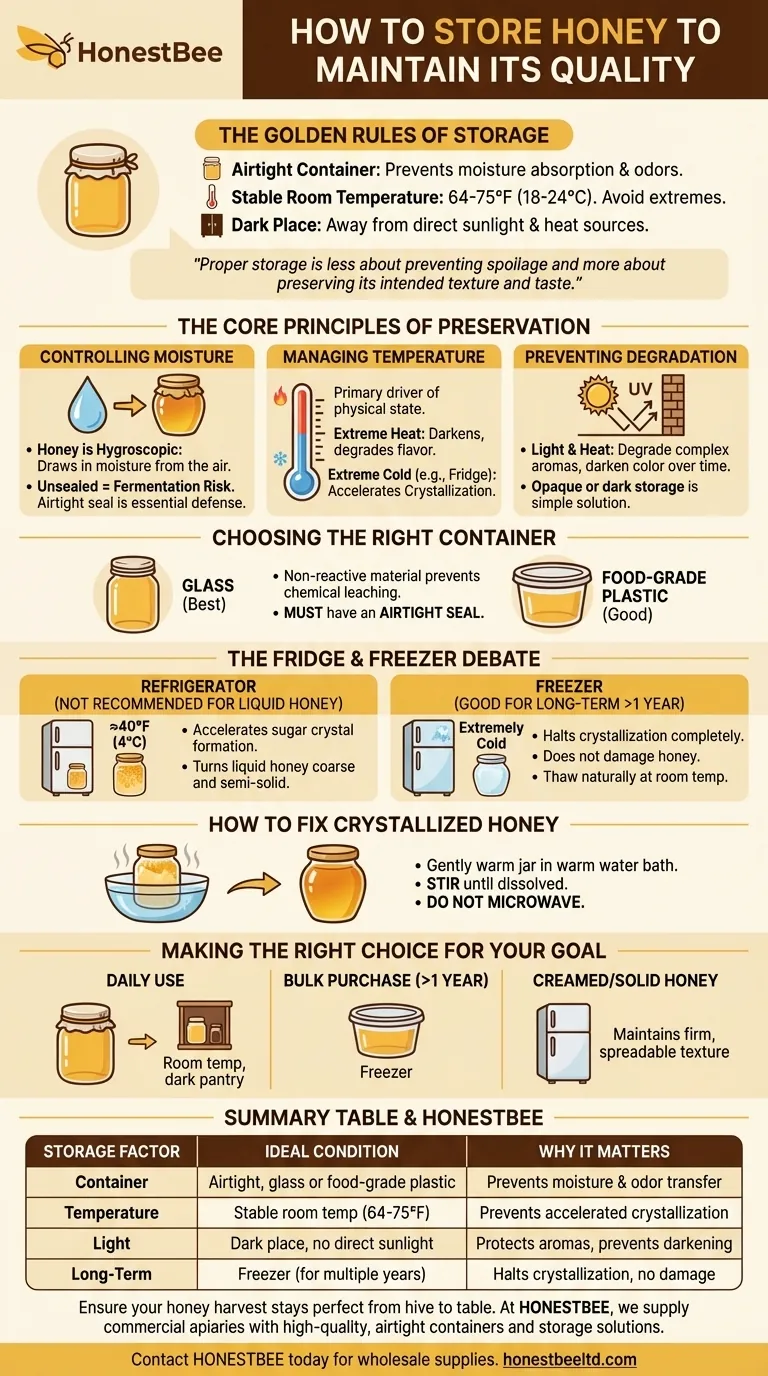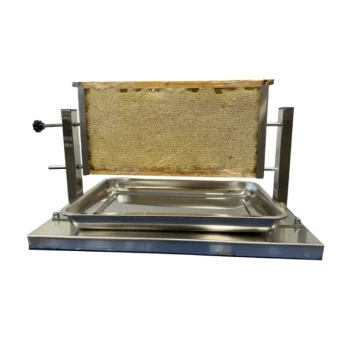To maintain its quality, honey must be stored in a sealed, airtight container at a stable room temperature, ideally between 64-75°F (18-24°C). Keep it in a dark place, like a pantry or cupboard, away from direct sunlight and sources of heat such as your stove. This simple method protects it from its primary enemies: moisture, temperature fluctuations, and light.
Honey is a remarkably stable food, but its longevity depends on defending it from its two greatest threats: moisture absorption, which can cause fermentation, and temperature extremes, which accelerate crystallization and degrade its delicate flavors. Proper storage is less about preventing spoilage and more about preserving its intended texture and taste.

The Core Principles of Honey Preservation
Understanding why these storage rules exist is the key to mastering them. Honey's unique chemical makeup makes it susceptible to specific environmental factors.
Controlling Moisture: Honey's Hygroscopic Nature
Honey is hygroscopic, meaning it has a low water content and will actively draw moisture from the surrounding air.
If left unsealed, honey can absorb enough water to raise its internal moisture level above the critical ~18% threshold. This excess water allows naturally present yeasts to activate and begin fermentation, spoiling the honey. An airtight container is your single most important defense against this.
Managing Temperature: The Enemy of Texture and Aroma
Temperature is the primary driver of honey's physical state. Extreme heat or cold will alter its quality, just in different ways.
Heat (from sunlight or a stove) can darken honey, change its flavor profile, and degrade the beneficial enzymes it contains. Conversely, cold temperatures are the main cause of crystallization.
The Role of Light: Preventing Degradation
Direct exposure to UV light can have a similar effect as heat. Over time, sunlight will degrade the quality of the honey, diminishing its complex aromas and contributing to a darker color. Storing it in a dark cupboard or an opaque container is a simple and effective solution.
Choosing the Right Container
The container you use is an active part of your storage strategy. Its material and seal are critical for long-term quality.
Why Material Matters: Glass vs. Plastic
The ideal honey container is made from a non-reactive material. This prevents any chemicals from leaching into the honey and altering its taste.
Glass jars are the gold standard because glass is inert and impermeable. Food-grade plastic is also a perfectly acceptable and lightweight alternative, as long as it is designed for food storage. Avoid storing honey in unlined metal containers.
The Importance of an Airtight Seal
A tight-fitting lid is non-negotiable. It not only prevents moisture from getting in but also stops the honey from absorbing strong odors from other foods in your pantry.
Understanding the Trade-offs: The Fridge and Freezer Debate
While room temperature storage is the universal recommendation, it's worth understanding what happens when you refrigerate or freeze honey.
The Refrigerator: A Recipe for Crystallization
Storing honey in the refrigerator is generally not recommended. The cool temperatures, typically around 40°F (4°C), provide the perfect conditions to accelerate the formation of sugar crystals.
This will turn your liquid honey into a thick, coarse, and semi-solid state much faster than it would at room temperature. Crystallization is not spoilage, but it changes the texture.
The Freezer: A Viable Long-Term Option
Surprisingly, the freezer is a better option than the refrigerator for very long-term storage. The extremely cold temperatures lock the molecules in place, completely halting the crystallization process.
Freezing does not damage the honey. When you are ready to use it, simply let it thaw naturally at room temperature. This is only necessary if you need to store honey for multiple years.
How to Fix Crystallized Honey
If your honey crystallizes, do not throw it away. You can easily return it to its liquid state by placing the jar in a bowl of warm (not boiling) water and stirring gently until the crystals dissolve. Avoid microwaving, as it can overheat the honey and degrade its quality.
Making the Right Choice for Your Goal
Your storage method should align with how you plan to use your honey.
- If your primary focus is daily use: Store it in a sealed glass jar at room temperature in a dark pantry.
- If your primary focus is preserving a large bulk purchase for over a year: Transfer it to freezer-safe containers and place it in the freezer.
- If your primary focus is storing creamed or solid honey: The refrigerator is acceptable, as it will help maintain its firm, spreadable texture.
By controlling its environment, you can ensure your honey remains a high-quality product for years to come.
Summary Table:
| Storage Factor | Ideal Condition | Why It Matters |
|---|---|---|
| Container | Airtight, glass or food-grade plastic | Prevents moisture absorption and odor transfer |
| Temperature | Stable room temperature (64-75°F / 18-24°C) | Prevents accelerated crystallization and flavor degradation |
| Light | Dark place, away from direct sunlight | Protects delicate aromas and prevents darkening |
| Long-Term Storage | Freezer (for multiple years) | Halts crystallization completely without damaging honey |
Ensure your honey harvest stays perfect from hive to table.
Proper storage is the final, critical step in delivering a premium product. At HONESTBEE, we supply commercial apiaries and beekeeping equipment distributors with the high-quality, airtight containers and storage solutions needed to protect honey's integrity.
Our wholesale-focused operations provide the durable equipment that safeguards your product's quality, ensuring your customers receive honey with its flavor and texture perfectly preserved.
Contact HONESTBEE today to discuss wholesale supplies for your commercial beekeeping needs.
Visual Guide

Related Products
- Stainless Steel Honey Tank Stand for Honey Storage
- Portable Uncapping Tank Holder Uncapping Bench for Beekeeping
- Honey Gate Valve with Ergonomic Ball Handle Plastic Bee Honey Tap for Beekeeping Bottling and Honey Extractor Equipment
- High Quality Honey Dehumidifier Dryer Thickening Machine for Beekeeping
- Honey Concentrating Vacuum Heating Thickening Machine Dehumidifier for Honey
People Also Ask
- How does high humidity alter the flavour of honey? Prevent Fermentation & Flavor Loss
- What is the optimal temperature for honey crystallization? Control Texture for Liquid or Creamed Honey
- What is the main difference in appearance and shelf life between raw and processed honey? A Guide for Beekeepers
- How long should honey sit before bottling? Achieve Crystal-Clear, Professional Honey
- How do honeybees generate heat during winter? The Superorganism's Survival Strategy



















